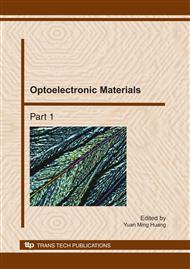p.926
p.930
p.934
p.939
p.943
p.947
p.952
p.956
p.961
Analysis of Barium-Bearing Glass Doped with Chromium Oxide
Abstract:
Barium-bearing glass samples were fabricated in a laboratory scale using quartz sands that was a by-product of feldspar floatation in Tak Province, northern Thailand, and 30-wt% barite from Loei Province, northeastern Thailand, as the main compositions. Cr2O3 of concentrations ranging from 0.01 to 5.0 wt% was doped into the glass mixture. The dried powders were wellmixed in a ceramic crucible and melted in an electric furnace at 1250°C for 6 hr. Bubble-free glass samples were yielded after cooling down. The glass colors were changed from colorless to green by the addition of Cr2O3. Dielectric property, color, specific gravity, and refractive index of the glass samples were analyzed. It was found that dielectric constant, specific gravity, and refractive index increased with increasing amount of Cr2O3 dopant. Measurements of UV-VIS-NIR spectra and microstuctural analysis using scanning electron microscope were also carried out and discussed.
Info:
Periodical:
Pages:
943-946
Citation:
Online since:
November 2010
Price:
Сopyright:
© 2011 Trans Tech Publications Ltd. All Rights Reserved
Share:
Citation:


